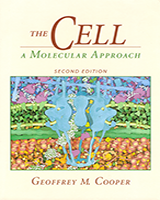By agreement with the publisher, this book is accessible by the search feature, but cannot be browsed.
NCBI Bookshelf. A service of the National Library of Medicine, National Institutes of Health.
Cooper GM. The Cell: A Molecular Approach. 2nd edition. Sunderland (MA): Sinauer Associates; 2000.

The Cell: A Molecular Approach. 2nd edition.
Show detailsHEREDITY, GENES, AND DNA
Genes and Chromosomes
Chromosomes are the carriers of genes.
KEY TERMS: gene, allele, dominant, recessive, genotype, phenotype, chromosome, diploid, meiosis, haploid, mutation, recombination, genetic map
Genes and Enzymes
A gene specifies the amino acid sequence of a polypeptide chain.
KEY TERMS: one gene-one enzyme hypothesis
Identification of DNA as the Genetic Material
DNA was identified as the genetic material by bacterial transformation experiments.
KEY TERMS: transformation
The Structure of DNA
DNA is a double helix in which hydrogen bonds form between purines and pyrimidines on opposite strands. Because of specific base pairing—A with T and G with C—the two strands of a DNA molecule are complementary in sequence.
Replication of DNA
DNA replicates by semiconservative replication, in which the two strands separate and each serves as a template for synthesis of a new progeny strand.
KEY TERMS: semiconservative replication, DNA polymerase
EXPRESSION OF GENETIC INFORMATION
Colinearity of Genes and Proteins
The order of nucleotides in DNA specifies the order of amino acids in proteins.
The Role of Messenger RNA
Messenger RNA functions as an intermediate to convey information from DNA to the ribosomes, where it serves as a template for protein synthesis.
KEY TERMS: central dogma, transcription, translation, messenger RNA (mRNA), RNA polymerase, ribosomal RNA (rRNA), transfer RNA (tRNA)
The Genetic Code
Transfer RNAs serve as adaptors between amino acids and mRNA during translation. Each amino acid is specified by a codon consisting of three nucleotides.
KEY TERMS: genetic code, in vitro translation, codon
RNA Viruses and Reverse Transcription
DNA can be synthesized from RNA templates, as first discovered in retroviruses.
KEY TERMS: retrovirus, reverse transcription, reverse transcriptase
RECOMBINANT DNA
Restriction Endonucleases
Restriction endonucleases cleave specific DNA sequences, yielding defined fragments of DNA molecules.
KEY TERMS: restriction endonuclease, gel electrophoresis, restriction map
Generation of Recombinant DNA Molecules
Recombinant DNA molecules consist of a DNA fragment of interest ligated to a vector that is able to replicate independently in an appropriate host cell.
KEY TERMS: molecular cloning, vector, recombinant molecule, molecular clone, DNA ligase, cDNA
Vectors for Recombinant DNA
A variety of vectors are used to clone different sizes of DNA fragments.
KEY TERMS: plasmid, origin of replication, cosmid, yeast artificial chromosome (YAC)
DNA Sequencing
The nucleotide sequences of cloned DNA fragments can be readily determined.
KEY TERMS: dideoxynucleotide, autoradiography
Expression of Cloned Genes
The proteins encoded by cloned genes can be expressed at high levels in either bacteria or eukaryotic cells.
KEY TERMS: expression vector, baculovirus
Amplification of DNA by the Polymerase Chain Reaction
PCR allows the amplification and isolation of specific fragments of DNA in vitro.
KEY TERMS: polymerase chain reaction (PCR)
DETECTION OF NUCLEIC ACIDS AND PROTEINS
Nucleic Acid Hybridization
Nucleic acid hybridization allows the detection of specific DNA or RNA sequences.
KEY TERMS: nucleic acid hybridization, probe, Southern blotting, Northern blotting, in situ hybridization
Detection of Small Amounts of DNA or RNA by PCR
PCR provides a sensitive method for detecting small amounts of specific DNA or RNA molecules.
Antibodies as Probes for Proteins
Antibodies are used to detect specific proteins in cells or cell extracts.
KEY TERMS: antibody, antigen, monoclonal antibody, immunoblotting, Western blotting, immunoprecipitation, SDS-polyacrylamide gel electrophoresis (SDS-PAGE)
Probes for Screening Recombinant DNA Libraries
Specific DNA inserts can be detected in recombinant DNA libraries by the use of either nucleic acid hybridization or antibody probes.
KEY TERMS: recombinant DNA library, genomic library, cDNA library
GENE FUNCTION IN EUKARYOTES
Genetic Analysis in Yeasts
The simple genetics and rapid replication of yeasts facilitate the molecular cloning of a gene corresponding to any yeast mutation.
KEY TERMS: temperature-sensitive mutant
Gene Transfer in Plants and Animals
Cloned genes can be introduced into complex eukaryotic cells and multicellular organisms for functional analysis.
KEY TERMS: gene transfer, transfection, transient expression, liposome, electroporation, transgenic mouse, embryonal stem (ES) cell, Ti plasmid
Mutagenesis of Cloned DNAs
In vitro mutagenesis of cloned DNAs is used to study the effect of engineered mutations on gene function.
KEY TERMS: reverse genetics, in vitro mutagenesis
Introducing Mutations into Cellular Genes
Mutations can be introduced into chromosomal gene copies by homologous recombination with cloned DNA sequences. In addition, the expression or function of specific gene products can be blocked by antisense nucleic acids or dominant inhibitory mutants.Chapter 3
KEY TERMS: homologous recombination, antisense nucleic acids, dominant inhibitory mutant
- Summary - The CellSummary - The Cell
Your browsing activity is empty.
Activity recording is turned off.
See more...